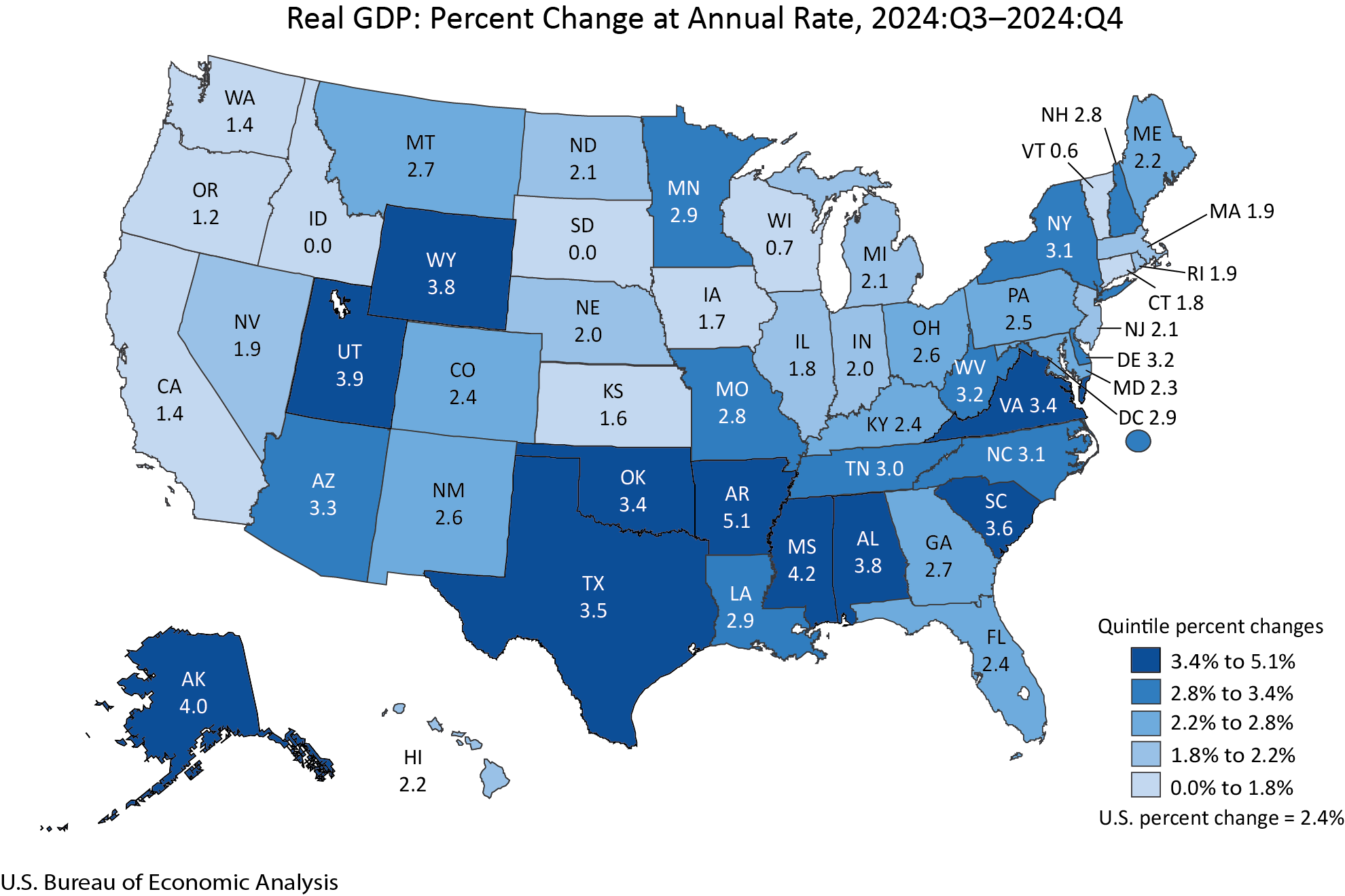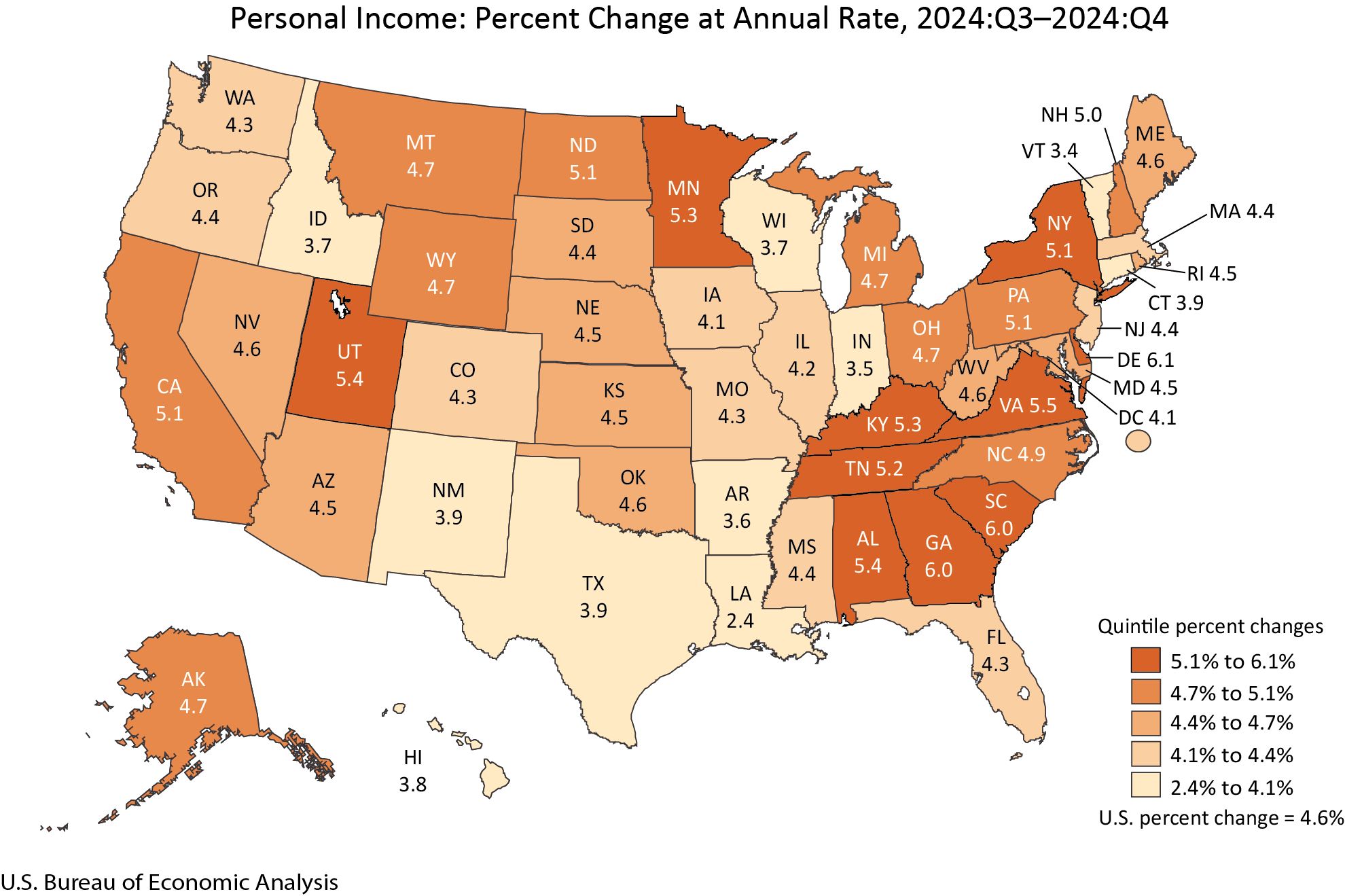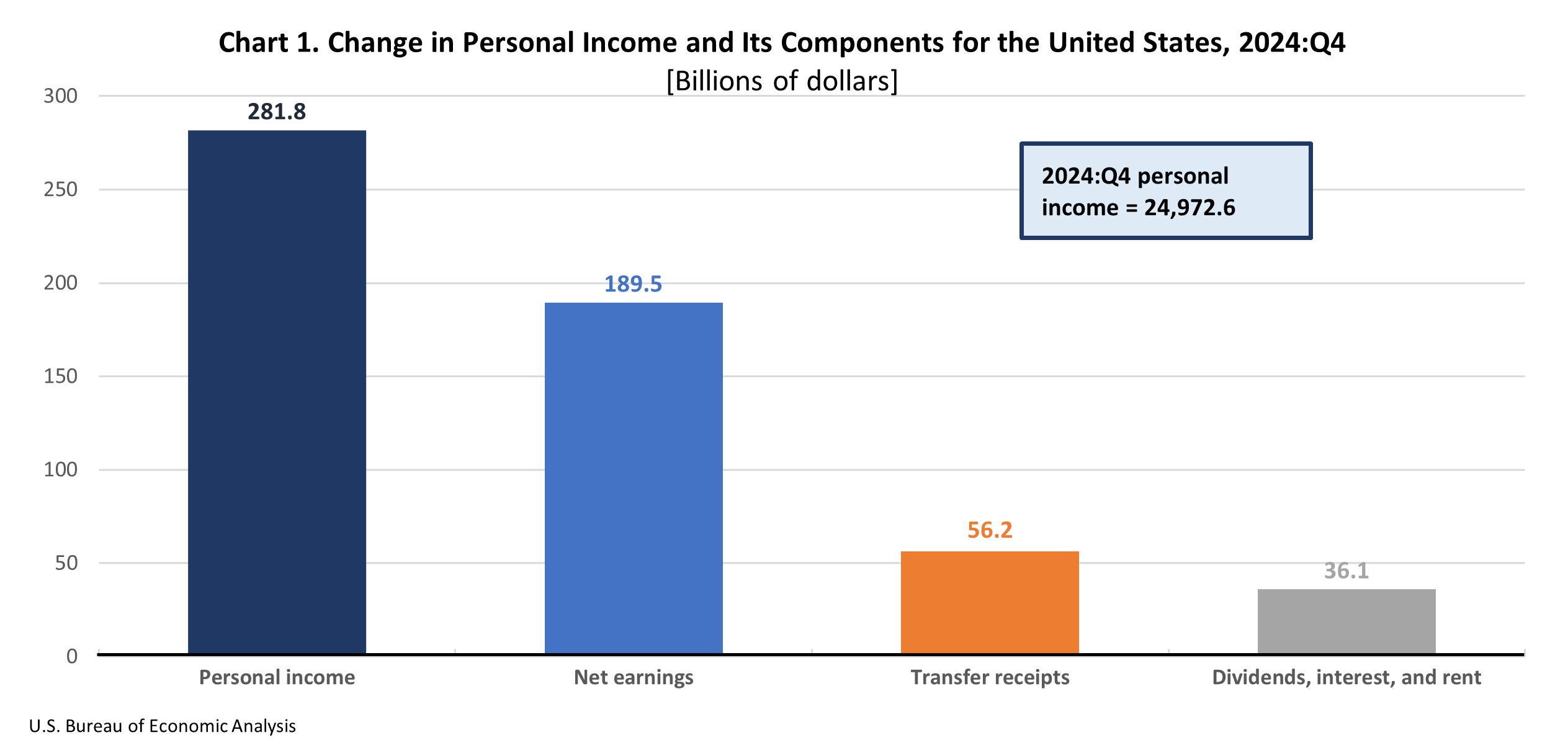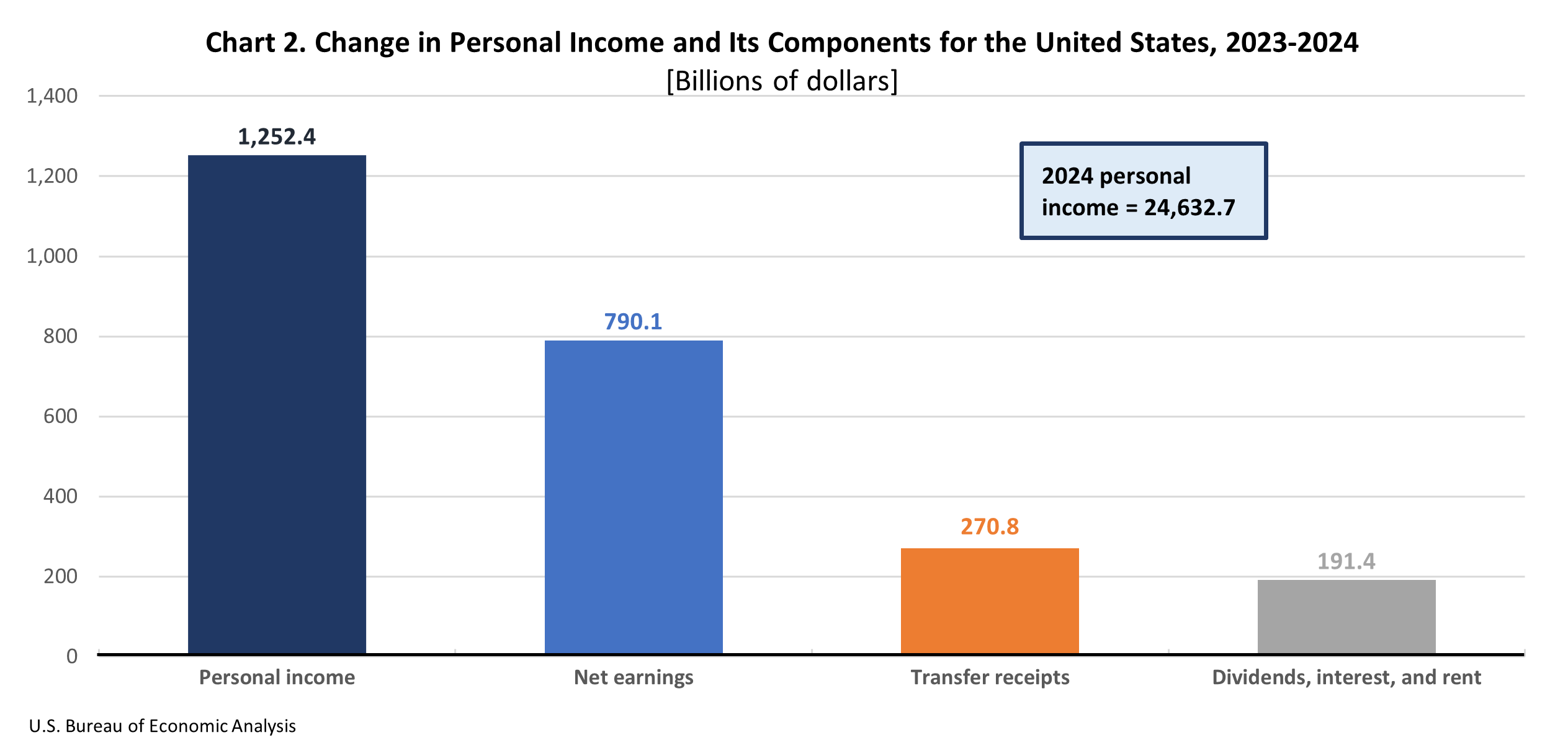News Release
Gross Domestic Product by State and Personal Income by State, 4th Quarter 2024 and Preliminary 2024
Real gross domestic product (GDP) increased in 48 states and the District of Columbia in the fourth quarter of 2024, with the percent change ranging from 5.1 percent at an annual rate in Arkansas to 0.6 percent in Vermont and remaining unchanged in Idaho and South Dakota, according to statistics released today by the U.S. Bureau of Economic Analysis (table 1). Current-dollar GDP increased in all 50 states and the District of Columbia. For the year 2024, real, or inflation-adjusted, GDP also increased in 48 states and the District of Columbia.
Personal income, in current dollars, increased in all 50 states and the District of Columbia in the fourth quarter of 2024, with the percent change ranging from 6.1 percent at an annual rate in Delaware to 2.4 percent in Louisiana (table 4). For the year 2024, current-dollar personal income also increased in all 50 states and the District of Columbia.
Quarterly GDP
In the fourth quarter of 2024, real GDP for the nation grew at an annual rate of 2.4 percent. Real GDP increased in 15 of the 23 industry groups for which BEA prepares quarterly state estimates. Real estate and rental and leasing; professional, scientific, and technical services; and health care and social assistance were the leading contributors to growth in real GDP nationally (table 2).
- Agriculture, forestry, fishing, and hunting, which increased in 17 states, was the leading contributor to growth in six states including Arkansas, Mississippi, and Alabama, the states with the first-, second-, and fifth-largest increases in real GDP, respectively.
- Mining, which increased in 45 states, was the leading contributor to growth in five states including Alaska, the state with the third-largest increase in real GDP.
- Construction, which increased in 48 states and the District of Columbia, was the leading contributor to growth in Utah, the fourth-largest growing state.
Annual GDP
In 2024, real GDP for the nation grew at an annual rate of 2.8 percent, with the percent change ranging from 4.5 percent in Utah to –0.7 percent in North Dakota (table 1). Real GDP increased in 19 of the 23 industry groups for which BEA prepares preliminary annual state estimates. Retail trade; health care and social assistance; and professional, scientific, and technical services were the leading contributors to growth in real GDP nationally (table 3).
- Retail trade, which increased in all 50 states and the District of Columbia, was the leading contributor to growth in 30 states. Retail trade was one of the leading contributors in Utah, the state with the largest increase in real GDP.
- Nondurable-goods manufacturing, which increased in 49 states, was the leading contributor to growth in four states including South Carolina, the state with the second-largest increase in real GDP.
- Agriculture, forestry, and fishing, which increased in 36 states, was the leading contributor to growth in two states including Idaho, the third-largest growing state.
Quarterly personal income
In the fourth quarter of 2024, current-dollar personal income increased $281.8 billion, or 4.6 percent at an annual rate (table 5). Nationally, increases in earnings, transfer receipts, and property income (dividends, interest, and rent) contributed to the increase in personal income (chart 1).
Earnings increased in all 50 states and the District of Columbia, while growing 5.1 percent nationally. The percent change in earnings ranged from 7.3 percent in Mississippi to 3.1 percent in Idaho. Earnings increased in 23 of the 24 industries for which BEA prepares quarterly estimates and was the largest contributor to growth in personal income in all 50 states and the District of Columbia (tables 5 and 6).
- Farm earnings, which increased in 40 states, was the leading contributor to the increase in Delaware, South Carolina, Georgia, and Alabama, the states with the first-, second-, third-, and fifth-largest growth in personal income, respectively.
- In Virginia, the state with the fourth-largest increase in personal income, professional, scientific, and technical services was the leading contributor to the increase in earnings.
- In Utah, the state with the sixth-largest increase in personal income, construction and state and local government were the leading contributors to the increase in earnings.
Transfer receipts increased in 47 states, while growing 5.0 percent nationally. The percent change in transfer receipts ranged from 9.4 percent in California to –2.4 percent in Louisiana (table 5).
Property income increased in all 50 states and the District of Columbia, while growing 2.9 percent nationally. The percent change ranged from 4.0 percent in Idaho to 2.0 percent in Alaska (table 5).
Annual personal income
In 2024, personal income for the nation increased at an annual rate of 5.4 percent, with the percent change ranging from 6.9 percent in North Carolina to 0.1 percent in North Dakota (table 7).
Nationally, increases in earnings, transfer receipts, and property income contributed to the increase in personal income (chart 2).
Earnings increased in 49 states and the District of Columbia, while growing 5.5 percent nationally. The percent change in earnings ranged from 7.0 percent in Hawaii to –2.0 percent in North Dakota (table 7). Earnings increased in 21 of the 24 industries for which BEA prepares annual estimates (table 8). Health care and social assistance; state and local government; and professional, scientific, and technical services were the leading contributors to the increase in earnings for the nation.
- In South Carolina, the state with the second-largest increase in personal income, growth in state and local government earnings was the leading contributor to the increase in personal income.
Transfer receipts increased in 50 states and the District of Columbia, while growing 6.3 percent nationally. The percent change in transfer receipts ranged from 11.8 percent in North Carolina to 1.7 percent in Arkansas (table 7).
- In North Carolina and California, the states with the first- and third-largest increase in personal income, growth in Medicaid benefits was the leading contributor to the increase in personal income.
Property income increased in all 50 states and the District of Columbia, while growing 4.0 percent nationally. The percent change ranged from 5.1 percent in Idaho to 3.3 percent in Hawaii (table 7).
Update of state statistics
Today, BEA also released revised quarterly estimates of personal income by state for the first quarter of 2024 through the third quarter of 2024. This update incorporates new and revised source data that are more complete and more detailed than previously available and aligns the states with the national estimates from the National Income and Product Accounts released on March 27, 2025.
BEA also released new estimates of per capita personal income for the fourth quarter of 2024, along with revised estimates for the second quarter of 2020 through the third quarter of 2024. BEA used U.S. Census Bureau population figures to calculate per capita personal income estimates for the second quarter of 2020 through the fourth quarter of 2024. BEA also used new Census Bureau population figures to update annual 2020 to 2023 per capita personal income statistics and to produce new per capita personal income statistics for 2024.
Next release: June 27, 2025, at 10:00 a.m. EDT
Gross Domestic Product by State and Personal Income by State, 1st Quarter 2025



